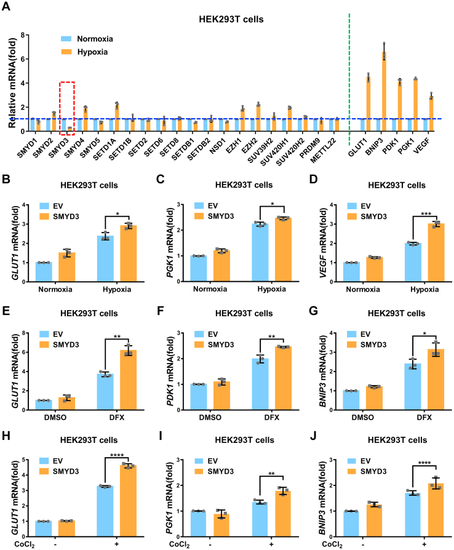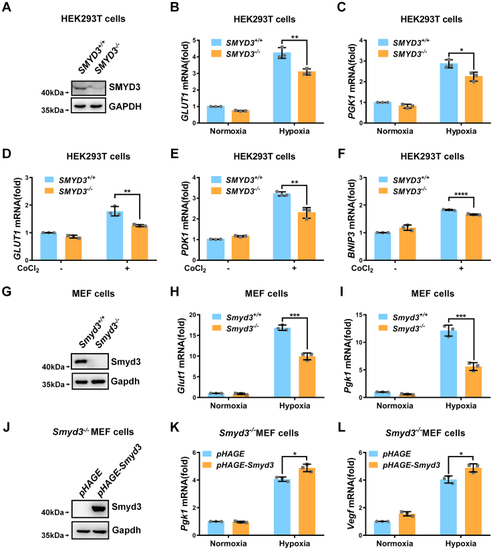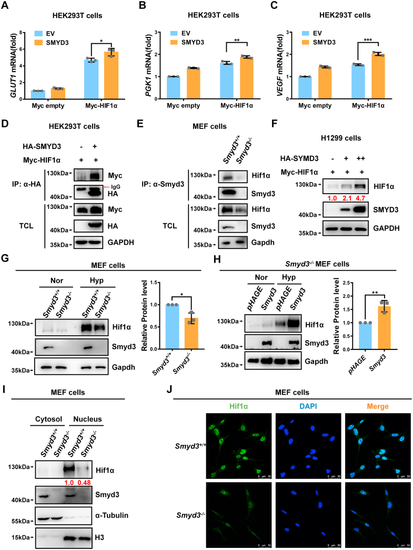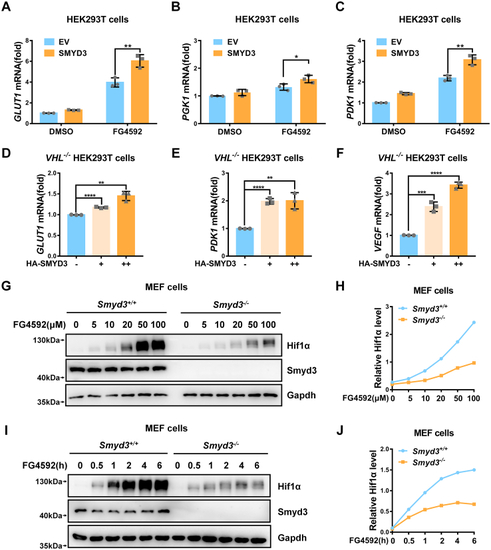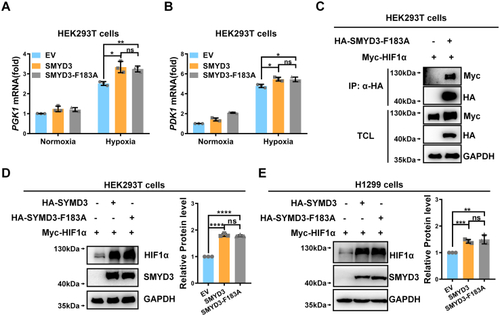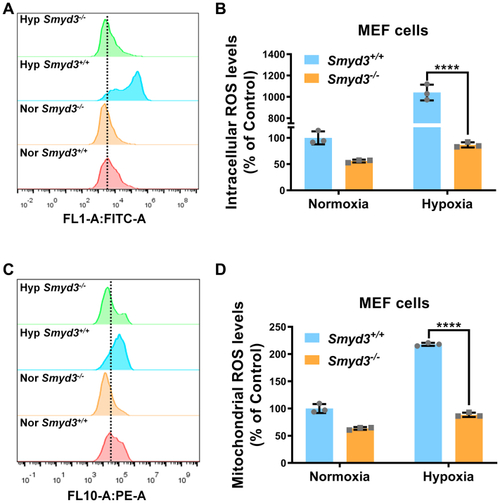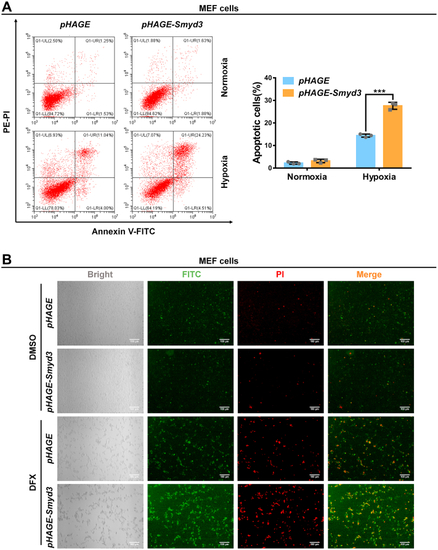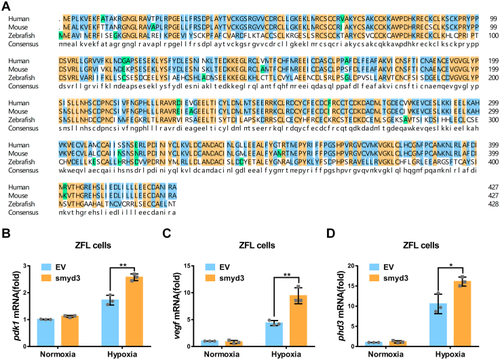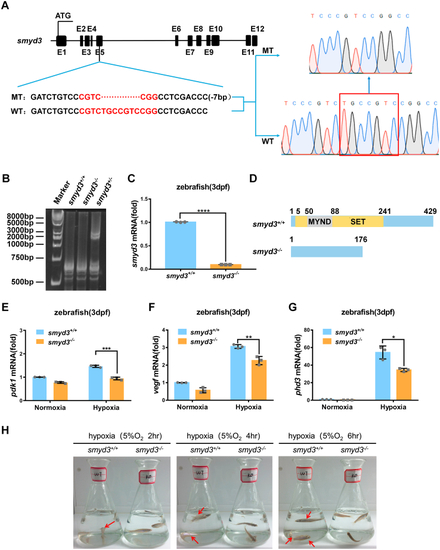- Title
-
Methyltransferase SMYD3 impairs hypoxia tolerance by augmenting hypoxia signaling independent of its enzymatic activity
- Authors
- Wang, Z., Chen, X., Fan, S., Zhu, C., Deng, H., Tang, J., Sun, X., Jia, S., Liao, Q., Xiao, W., Liu, X.
- Source
- Full text @ J. Biol. Chem.
|
SMYD3 augments hypoxia signaling. A, quantitative real-time PCR (qPCR) analysis of mRNA levels of indicated lysine methyltransferase genes and hypoxia signaling target genes in HEK293T cells under normoxia (21% O2) or hypoxia (1% O2) for 24 h. B?D, qPCR analysis of GLUT1 (B), PGK1 (C), and VEGF (D) mRNA in HEK293T cells transfected with or without pCMV-SMYD3 under normoxia (21% O2) or hypoxia (1% O2) for 24 h. E?G, qPCR analysis of GLUT1 (E), PDK1 (F), and BNIP3 (G) mRNA in HEK293T cells transfected with or without pCMV-SMYD3 and treated with DFX (150 ?M) or DMSO as a control for 8 h. H?J, qPCR analysis of GLUT1 (H), PGK1 (I), and BNIP3 (J) mRNA in HEK293T cells transfected with or without pCMV-SMYD3 and treated with or without CoCl2 (200 ?M) for 8 h. EV, pCMV empty vector (control). Data show mean ± SD; Student?s two-tailed t test. ?p < 0.05, ??p < 0.01, ???p < 0.001, ????p < 0.0001. Data from three independent experiments. |
|
Loss of SMYD3 diminishes hypoxia signaling. A, immunoblotting of indicated proteins in SMYD3-deficient or wildtype HEK293T cells (SMYD3?/? or SMYD3+/+). B and C, qPCR analysis of GLUT1 (B) and PGK1 (C) mRNA in SMYD3-deficient or wildtype HEK293T cells (SMYD3?/? or SMYD3+/+) under normoxia (21% O2) or hypoxia (1% O2) for 24 h. Data show mean ± SD; Student?s two-tailed t test. ?p < 0.05, ??p < 0.01. Data from three independent experiments. D?F, qPCR analysis of GLUT1 (D), PDK1 (E), and BNIP3 (F) mRNA in SMYD3-deficient or wildtype HEK293T cells (SMYD3?/? or SMYD3+/+) treated with or without CoCl2 (200 ?M) for 8 h. Data show mean ± SD; Student?s two-tailed t test. ??p < 0.01, ????p < 0.0001. Data from three independent experiments. G, immunoblotting of indicated proteins in Smyd3-deficient or wildtype MEF cells (Smyd3?/? or Smyd3+/+). H and I, qPCR analysis of Glut1 (H) and Pgk1 (I) mRNA in Smyd3-deficient or wildtype MEF cells (Smyd3?/? or Smyd3+/+) under normoxia (21% O2) or hypoxia (1% O2) for 24 h. Data show mean ± SD; Student?s two-tailed t test. ???p < 0.001. Data from three independent experiments. J, immunoblotting of indicated proteins in Smyd3-deficient MEF cells reconstituted with or without wildtype Smyd3 by lentivirus. K and L, qPCR analysis of Pgk1 (K) and Vegf (L) mRNA in Smyd3-deficient MEF cells reconstituted with or without wildtype Smyd3 by lentivirus under normoxia (21% O2) or hypoxia (1% O2) for 24 h. Data show mean ± SD; Student?s two-tailed t test. ?p < 0.05. Data from three independent experiments. qPCR, quantitative RT?PCR; MEF, mouse embryonic fibroblast. |
|
SMYD3 binds to and stabilizes HIF1?, leading to an increase of nuclear HIF1? and enhancement of HIF1?-mediated target genes expression.A?C, qPCR analysis of GLUT1 (A), PGK1 (B), and VEGF (C) mRNA in HEK293T cells cotransfected with Myc-HIF1? or Myc empty vector (control) together with pCMV-SMYD3 or pCMV empty vector (EV) (control) for 24 h. Data show mean ± SD; Student?s two-tailed t test. ?p < 0.05, ??p < 0.01, ???p < 0.001. Data from three independent experiments. D, co-immunoprecipitation of HA-SMYD3 with Myc-HIF1?. HEK293T cells were co-transfected with indicated plasmids for 24 h. Anti-HA antibody-conjugated agarose beads were used for immunoprecipitation, and the interaction was detected by immunoblotting with the indicated antibodies. E, endogenous interaction between Smyd3 and Hif1?. Smyd3-deficient or wildtype MEF cells (Smyd3?/? or Smyd3+/+) under hypoxia for 4 h and anti-HIF1? antibody was used for immunoprecipitation. F, immunoblotting of exogenous Myc-HIF1? expression in H1299 cells transfected with an increasing amount of HA-SMYD3 expression plasmid (HA empty vector [-] was used as a control). G, immunoblotting of endogenous HIF1? expression in Smyd3-deficient or wildtype MEF cells (Smyd3?/? or Smyd3+/+) under normoxia (21% O2) or hypoxia (1% O2) for 4 h. The relative intensities of Hif1? were determined by normalizing the intensities of Hif1? to the intensities of Gapdh. Data show mean ± SD; Student?s two-tailed t test. ?p < 0.05. Data from three independent experiments. H, immunoblotting of endogenous Hif1? expression in Smyd3-deficient MEF cells reconstituted with or without wildtype Smyd3 by lentivirus under normoxia (21% O2) or hypoxia (1% O2) for 4 h. The relative intensities of Hif1? were determined by normalizing the intensities of Hif1? to the intensities of Gapdh. Data show mean ± SD; Student?s two-tailed t test. ??p < 0.01. Data from three independent experiments. I, Smyd3-deficient or wildtype MEF cells (Smyd3?/? or Smyd3+/+) were cultured under hypoxia for 4 h. Western blot analysis was used to detect Smyd3 and Hif1? in cytosol and nuclear fractions. J, confocal microscopy image of endogenous Hif1? in Smyd3-deficient or wildtype MEF cells (Smyd3?/? or Smyd3+/+) under hypoxia for 4 h. Scale bar = 50 ?m. MEF, mouse embryonic fibroblast; qPCR, quantitative RT?PCR; HIF, hypoxia-inducible factor. |
|
The induction of HIF1? target genes expression and stabilization of HIF1? by SMYD3 are independent of HIF1? hydroxylation and pVHL intactness. A?C, qPCR analysis of GLUT1 (A), PGK1 (B), and PDK1 (C) mRNA in HEK293T cells transfected with or without pCMV-SMYD3 for 24 h, followed by treatment with DMSO or FG4592 (100 ?M) for 8 h. EV, pCMV empty vector (control). Data show mean ± SD; Student?s two-tailed t test. ?p < 0.05, ??p < 0.01. Data from three independent experiments. D?F, qPCR analysis of GLUT1 (D), PDK1 (E), and VEGF (F) mRNA in VHL-deficient HEK293T cells (VHL?/?) transfected with an increasing amount of pCMV-SMYD3 expression plasmid. pCMV empty vector was used as a control (-). Data show mean ± SD; Student?s two-tailed t test. ??p < 0.01, ???p < 0.001, ????p < 0.0001. Data from three independent experiments. G, immunoblotting of endogenous Hif1? expression in Smyd3-deficient or wildtype MEF cells (Smyd3?/? or Smyd3+/+) treated with an increasing amount of FG4592 for 6 h. H, the relative intensities of Hif1? in (G) determined by normalizing the intensities of Hif1? to the intensities of Gapdh. I, immunoblotting of endogenous Hif1? expression in Smyd3-deficient or wildtype MEF cells (Smyd3?/? or Smyd3+/+) treated with an increasing time of FG4592 (100 ?M) for 0 to 6 h. J, the relative intensities of Hif1? in (I) determined by normalizing the intensities of Hif1? to the intensities of Gapdh. HIF, hypoxia-inducible factor; MEF, mouse embryonic fibroblast; qPCR, quantitative RT?PCR; VHL, von Hippel-Lindau. |
|
SMYD3 stabilizes and activates HIF1? independent of its methyltransferase activity. A and B, qPCR analysis of PGK1 (A) and PDK1 (B) mRNA in HEK293T cells transfected with expression plasmids encoding wildtype SMYD3 or its enzymatically dead mutant SMYD3-F183A (HA empty vector [EV] was used as a control) under normoxia (21% O2) or hypoxia (1% O2) for 24 h. Data show mean ± SD; Student?s two-tailed t test. ns, not significant, ?p < 0.05, ??p < 0.01. Data from three independent experiments. C, co-immunoprecipitation of HA-SMYD3-F183A with Myc-HIF1?. HEK293T cells were cotransfected with indicated plasmids for 24 h. Anti-HA antibody-conjugated agarose beads were used for immunoprecipitation, and the interaction was detected by immunoblotting with the indicated antibodies. D and E, immunoblotting of exogenous Myc-HIF1? expression in HEK293T (D) or H1299 (E) cells transfected with expression plasmids encoding wildtype SMYD3 or its enzymatically dead mutant SMYD3-F183A (HA empty vector [-] was used as a control). The relative intensities of HIF1? were determined by normalizing the intensities of HIF1? to the intensities of GAPDH. Data show mean ± SD; Student?s two-tailed t test. ns, not significant, ??p < 0.01, ???p < 0.001, ????p < 0.0001. Data from three independent experiments. qPCR, quantitative RT?PCR; HIF, hypoxia-inducible factor. |
|
Deficiency of SMYD3 alleviates ROS accumulation. A and B, intracellular ROS levels in Smyd3-deficient or wildtype MEF cells (Smyd3?/? or Smyd3+/+) under normoxia or hypoxia detected by flow cytometry analysis. Data show mean ± SD; Student?s two-tailed t test. ????p < 0.0001. Data from three independent experiments. C and D, mitochondrial ROS levels in Smyd3-deficient or wildtype MEF cells (Smyd3?/? or Smyd3+/+) under normoxia or hypoxia detected by flow cytometry analysis. Data show mean + SD; Student?s two tailed t test. ????p < 0.0001. Data from three independent experiments. HIF, hypoxia-inducible factor; MEF, mouse embryonic fibroblast; ROS, reactive oxygen species. |
|
Disruption of SMYD3 protects cells against hypoxia-induced apoptosis. A, apoptotic cells in Smyd3-deficient or wildtype MEF cells (Smyd3?/? or Smyd3+/+) under normoxia or hypoxia detected by flow cytometry analysis. Data show mean ± SD; Student?s two-tailed t test. ??p < 0.01. Data from three independent experiments. B, apoptotic cells in Smyd3-deficient or wildtype MEF cells (Smyd3?/? or Smyd3+/+) under normoxia or hypoxia detected by fluorescence microscopy. Scale bar = 100 ?m. MEF, mouse embryonic fibroblast. |
|
Reconstitution of Smyd3 in Smyd3-deficient cells promotes hypoxia-induced apoptosis. A, apoptotic cells in Smyd3-deficient MEF cells reconstituted with or without wildtype Smyd3 by lentivirus under normoxia or hypoxia detected by flow cytometry analysis. Data show mean ± SD; Student?s two-tailed t test. ???p < 0.001. Data from three independent experiments. B, Smyd3-deficient MEF cells were reconstituted with or without wildtype Smyd3 by lentivirus and treated with DFX (150 ?M) or DMSO as a control for 24 h. Apoptotic cells were detected by fluorescence microscopy. Scale bar = 100 ?m. DFX, deferoxamine mesylate salt; MEF, mouse embryonic fibroblast. |
|
Zebrafish smyd3 augments hypoxia signaling. A, alignment of smyd3 amino acid sequences from human, mouse, and zebrafish, and the consensus sequence is shown below. B?D, qPCR analysis of pdk1 (B), vegf (C), and phd3 (D) mRNA in ZFL cells transfected with or without pCMV-smyd3 and cultured under normoxia (21% O2) or hypoxia (1% O2) for 24 h. EV, pCMV empty vector (control). Data show mean ± SD; Student?s two-tailed t test. ?p < 0.05, ??p < 0.01. Data from three independent experiments. qPCR, quantitative RT?PCR; ZFL, zebrafish liver. |
|
Disruption of smyd3 in zebrafish facilitates hypoxia tolerance. A, scheme of the sequence information in smyd3-null zebrafish. Seven?base pair nucleotides (5?-TGCCGTC-3?) were deleted in exon five of smyd3 in the mutant, resulting in a reading frame shift. B, verification of CRISPR/Cas9-mediated zebrafish smyd3 disruption by HMA (heteroduplex mobility assay). C, qPCR analysis of smyd3 mRNA in smyd3-deficient or wildtype zebrafish larvae (smyd3?/? or smyd3+/+) (3dpf). Data show mean ± SD; Student?s two-tailed t test. ????p < 0.0001. Data from three independent experiments. D, the predicted protein products of smyd3 in the mutants (176 aa) and their wildtype (429 aa) siblings. aa, amino acids. E?G, qPCR analysis of pdk1 (E), vegf (F), and phd3 (G) mRNA in smyd3-deficient or wildtype zebrafish larvae (smyd3?/? or smyd3+/+) (3dpf) under normoxia (21% O2) or hypoxia (2% O2). Data show mean ± SD; Student?s two-tailed t test. ?p < 0.05, ??p < 0.01, ???p < 0.001. Data from three independent experiments. H, the survival of wildtype (smyd3+/+; left flask) and smyd3-null (smyd3?/?; right flask) adult zebrafish (3mpf) after 2 h, 4 h, and 6 h under hypoxia (5% O2). Red arrows, dying zebrafish. qPCR, quantitative RT?PCR. EXPRESSION / LABELING:
PHENOTYPE:
|

